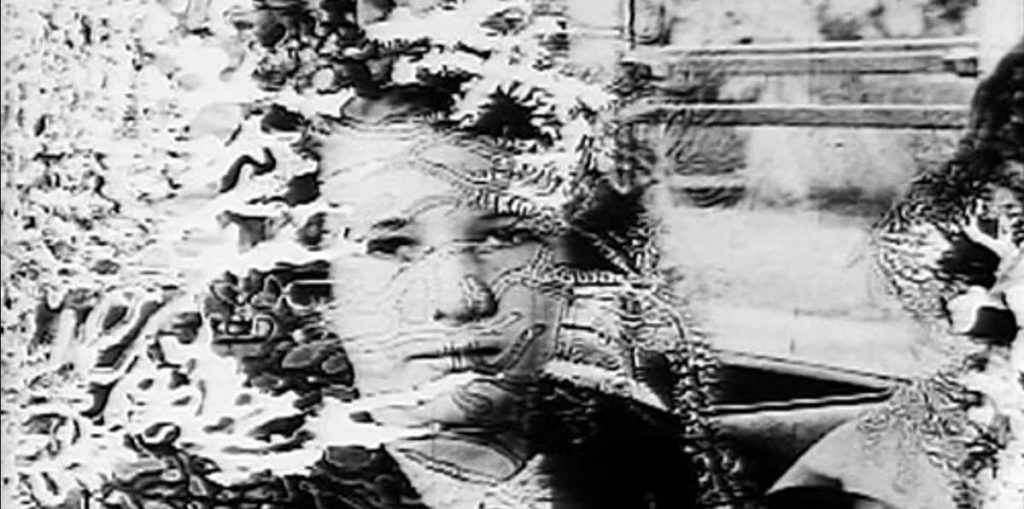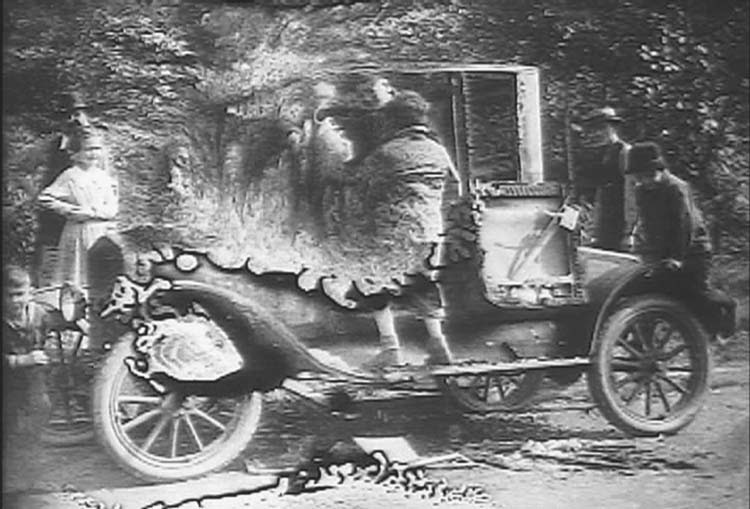Decasia Live Paired Decaying Footage, a Brass Band and a huge abandoned Synagogue to create the world’s Trippiest Avant Garde Event
By Andrew Phillips Posted in Live Review, Writing on September 13, 2020 0 Comments 7 min read

Indulgence is the most easily misunderstood aspect of avant-garde art. It’s not enough to pile up wildly adventurous ideas—you have to make them work together. That’s not to say disparate forms can’t sync seamlessly, but without some sense of a grand thematic structure, ambitious art becomes muddled beyond repair, leaving the audience to wander.
That’s all well and good if confusion is your conceit, but not if you’re actually trying to say something.
So where does that leave someone who wants to show violently decayed footage of long-dead Indians and camel crossings on screens in an old synagogue as an orchestra plays a strange and elusive live score? Walking a fine line indeed.
Envisioned by composer Michael Gordon and filmmaker Bill Morrison with the help of a number of other artists, Decasia Live is an interdisciplinary art piece which pairs a wildly avant-garde score with visual montages of exotic, decaying footage. And when I say “decaying,” I mean it quite literally: the images — taken from old stock footage — have begun to melt away with age and oxidation. Saving them from utter desolation, Morrison captured the distressed black-and-white scenes in their various states of decay, creating an unrelated series of psychedelic montages that melt in on themselves.
Needless to say, Decasia is an inspired idea, but, as I make my way towards the art space where tonight’s site-specific presentation will be performed, I still have my doubts: this will either be a stroke of artistic genius or a painfully executed act of over-indulgence. One or the other. There’s no in-between. As I enter the Angel Orensanz Center — a repurposed 19th-century synagogue abandoned in the slow dissolve of New York’s Yiddish Lower East Side — I’m struck by a sense of exulcerated history. By art-space standards, things look just fine, but that doesn’t stave one’s sense of the synagogue’s decay. Long, tan-grey arches reach above the great, open heights of the main hall, crisscrossing the peeling blue of the dome’s ceiling.

The once-grand bimah and backing altar are also damaged — not rusted or broken so much as dissolving, paint flecking in rude, unmanaged lines. A patchwork of threadbare rugs has been haphazardly placed along the floor of the enormous room. Intersecting at random, the rugs’ overlaps create bunches, bumps that give the illusion of waves in an untamed sea of material. Sitting cross-legged on a small patch in a corner, I rest my back against a large speaker, one of several subwoofers surrounding the main room. Taking a cue from others sprawled out on the carpets, I place my hands behind my head and lean back, staring at the 13 surrounding screens. Each of the long drapes hangs well above my head, shielding the balconies behind.
* * * BOOM! I’m woken from a momentary power-nap — these things happen when you find yourself staring into the dome of an old synagogue — by an explosion of sound. To say it radiates through me is an absolute truth: I’m shaken by the speaker at my back and fall forward, awkwardly crawling to the floor. Led by a matronly woman with fire-engine red hair, a small group of musicians has taken the pulpit. Surely they can’t be making all this racket? It’s a moment before I realize that the vast center of the room is surrounded, and that the majority of the Manhattan School of Music’s massive TACTUS Contemporary Ensemble’s members are hiding behind the screens.
While I can only see momentary flits of their faces through the canvas, I can feel the full-bodied sound of their 55-piece orchestra as light bangs begin to square off against the soft mew of strings.
Without warning, a single grainy image pops onto each of the surrounding screens. Mirrored on all sides of the room, a man appears in religious garb, dancing in a slow circle. The image seems rather random—if perhaps academically interesting — and the aesthetic is that of old family footage. Soon, minor lines create crags in the image, and the edges begin to blur. But what’s the big deal? Doesn’t look that decayed to me…
Soon we segue to a new clip, a group of travelers against the horizon, slowly crossing the desert on camels. This image repeats itself, and, as time passes, I find my eyes drifting from the screens to the hearth of the synagogue. The music bounces slowly up and down in some kind of demonic raga, as images dance on the synagogue’s bare accoutrements. Like charcoal etchings, the travelers are shadowy, but their movements are clearly outlined. It’s pretty, of course, but if I wanted to trip out to shadow puppets and weirdo music, I’d just set up a flashlight in my apartment and pull out a Harry Partch LP. Is this really all there is?
I’m busy considering the disadvantages of avant-garde excess when, again without warning, the orchestra kicks things up a notch. Suddenly the sparse-but-booming score is overtaken by heavy bells and yelping, long-bowed violins. It’s a startling change, one that draws my eyes back to the screens. The images have become grainy. What were once fairly clear scenes have become lines of strange static. The effect is like black-and-white Brakhage, with unrestrained shapes pulsing across the screen.
Then, out of the chaos, an image takes form, not superimposed but actually emerging from the anarchy. Whoa! Now that’s some trippy shit. Special-effects artists can only dream of this kind of control. The images are like negatives piled under lab slides — little mitosis-like lines shutterbug across the screen, obscuring what’s under as they pop in and out of focus. Faces melt, as if taken unexpectedly by some spontaneous wasting disease, degenerating into free-form pixels as they warp and bend. We see a group of men bouncing on Model T-like Ruff Ridas, only to be consumed in a flame-like burn of the reel.
Foreign soldiers carry wounded comrades as the torn footage pixelates, and their bodies become living impressionist paintings. As the brass rises in a discordant storm, people in a city street seem to catch fire: the decay of the footage bends the structure of their bodies, whipping them in contorted, specter-like wisps. Clarity returns in moments, only to be violently whisked away. A sharp buzz of controlled feedback fills the room, and the orchestra falls into an aggressive army brass processional anchored by the one-two hammer of heavy bass drums. Now we see the real power of the photo-capturing technique: a house that’s actually burning is shown clearly, but, compared to the images that weren’t actually on fire, it seems docile.
The orchestra unleashes a series of bass-heavy drones as we switch back and bodies continue to contort. It’s as if the screens are made of rubber and a hand is pushing from behind, welling the images in strange, unnatural ways. I said it earlier, but it bears repeating: no amount of special effects could bend and melt bodies like this. And no person could either: after all, this psychedelic storm is propelled by the whims of nature and the dispassionate burn of chemicals.
Before I know it, an hour has passed, and we’ve returned to the image of the camels crossing — their subtlety now a welcome cool down after a frenzy of violent images. And then the spinning dancer returns in his hat — excited and proud — ushering us out of our haze. The orchestra whips into a final surge and falls silent. I’m physically stunned, shaken by the overwhelming intensity of what’s unfolded. Overindulgence may be its muse and confusion its conceit, but damned if Decasia isn’t the absolute definition of inspired avant-garde art.